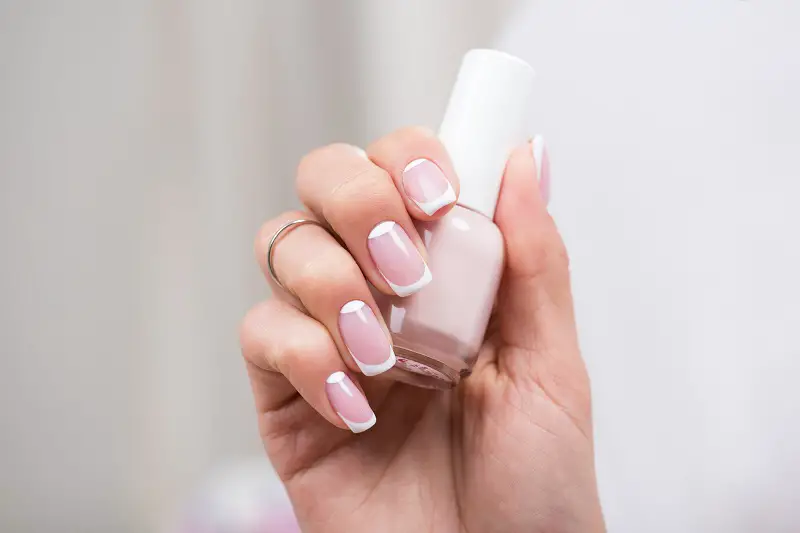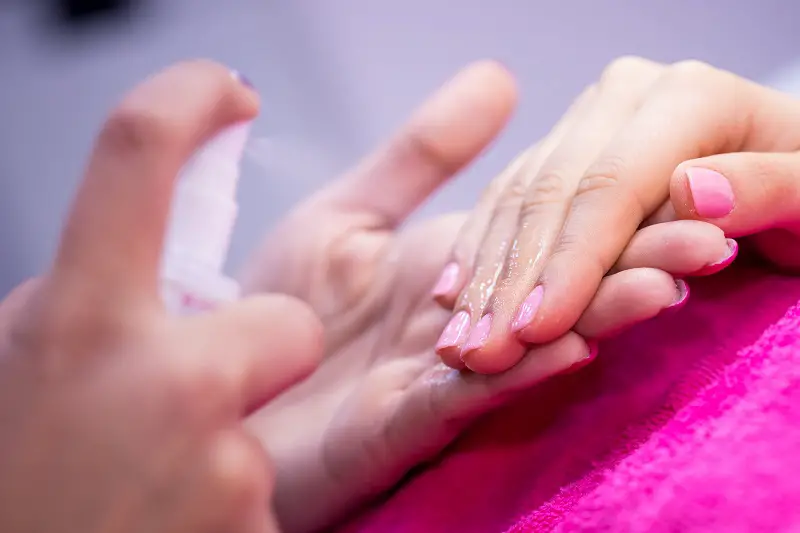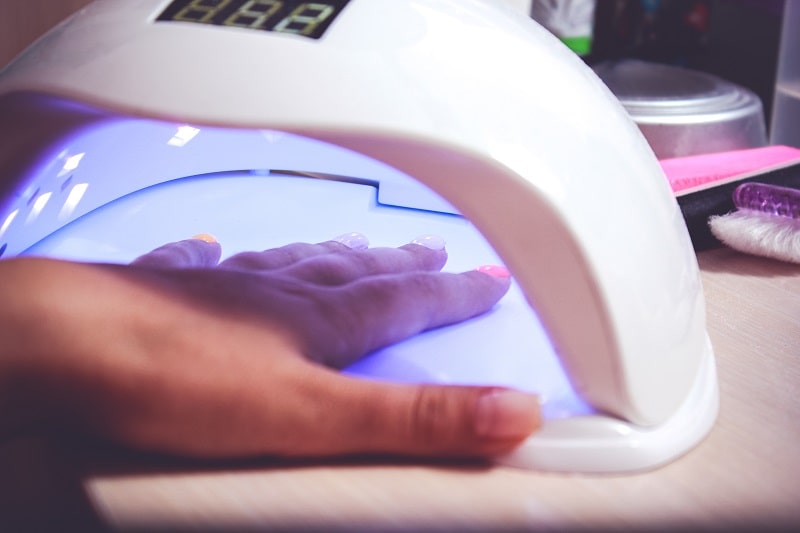If you’re like thousands of others that turned to learning the art of DIY home manicures during the pandemic you aren’t alone. Or, maybe you’ve seen the plethora of these people on social media and you’ve begun to spark an interest in investing in your own home nail salon.
You might have even started googling about what you’ll need to get started, but are wondering exactly where to begin. There are many questions you may have, such as, “Does UV light dry regular nail polish?” or, “How long does regular nail polish take to dry?”
I have all the answers you’re asking right here. Once you’ve read through this comprehensive article, you’ll have the knowledge you need to start making those nails beautiful from the comfort of your own home.
What Nail Polish Works With UV Light?
When choosing a nail polish to cure under a UV lamp, make sure you buy gel polish. Gel polish is specially formulated with photoinitiators that allow it to set and harden when exposed to UV light.
When photoinitiators are exposed to UV light, particles called free radicals are released. It is then that these free radicals kickstart the reaction with the resins of the gel, a change called polymerization.
Without getting too scientific, in order for a UV lamp to cure a set of nails, it needs a specially formulated gel polish with these compounds within to be effective. Don’t go out and just buy any type of gel polish, not all contain these chemicals, however, most do so ensure you check the labels before you purchase.
Can You Use UV Or LED Light To Dry Regular Nail Polish?
No, you cannot use UV or LED light to dry regular nail polish. Both UV and LED light can be used to dry gel nail polish, but regular nail polish must be air-dried. Regular nail polish won’t dry any faster if it’s placed under UV or LED Light.
While you’re more than welcome to place your hands under the glowing blue light after you paint your nails, it’s not going to do anything. Regular nail polish does not contain photoinitiators, therefore placing your nails under a UV or LED lamp isn’t going to help the drying process along at all.
When it comes to the science behind ‘normal’ or ‘regular’ nail polish, evaporation is the key. There are no fancy chemicals or compounds waiting to set off a chain reaction when exposed to UV or LED light. Just good, plain, old-fashioned air.
Ultraviolet rays are known to cause skin aging and cancer, so while drying your nails under a UV or LED lamp isn’t likely to do much damage, it’s better to avoid exposing your skin when it doesn’t need to be.
Does Rubbing Alcohol Dry Nail Polish?
If you have little patience to wait for your set of nails to dry on their own, you may turn to other methods to speed up the process. Rubbing alcohol is not one of them. Rubbing alcohol does the exact opposite. By breaking down the chemicals in your polish, rubbing alcohol softens your manicure and enables your polish to come off.
While you should never apply rubbing alcohol to a fresh set afterwards, there is, however, a method to allow for faster dry time using this substance. Instead of applying rubbing alcohol after, apply it before.
Nail preparation is extremely important and often overlooked when it comes to painting your nails. These fine details and extra steps can make a world of a difference not only to the end result, but in how quickly they dry, and how long they will last.
- Before any polish has been applied, file the surface of your nail to create a rough texture for the polish to grip onto.
- Then, buffer the surface to smooth out any irregularities caused by filing.
- Wipe away any excess oil or moisture from the nail with rubbing alcohol.
By wiping away any oil from your nail bed, you’re ensuring there is nothing to compromise your dry time.
How Long Does Regular Nail Polish Take To Dry?
If you’re someone that has long painted their nails, you know the feeling. You just spent time, focus, and concentration on the perfect freshly painted manicure. You’ve painted your nails a brilliant red, and used a toothpick to create white flowers around the edges.
After about 20 minutes you feel confident that they’re dry, only to accidentally bump them against your leg and smear the masterpiece you’ve just created. On average, it takes a typical set of regular nail polish one to two hours to fully, and completely dry. However, this time frame can vary according to a few factors.
Type Of Nail Polish
The most common brands of nail polish you can buy at the drugstore contain a toxic chemical called formaldehyde. While formaldehyde is useful in strengthening nail polish and preventing bacteria.
It’s been linked to a wide array of health conditions such as allergic reactions, nausea, and miscarriages. If you’re thinking, well I’ll just buy formaldehyde-free nail polish then! You certainly can, just be aware many of them have the longest dry times out of any formula.
- Nail polish with formaldehyde: One to two hours
- Nail polish without formaldehyde: Up to five hours
In response to the growing demand over nail polish dry times, many brands curated a ‘quick-dry’ formula to enable their consumers to go about their day in as little as a few minutes.
Quick-dry nail polish uses the same recipe and formula as regular nail polish, yet the ratio of ingredients differs. In quick-dry products, the level of solvent (the fastest evaporating chemical in polish) is higher, therefore allowing a faster dry time. Typically you can have a fully dry set of nails in around 15 minutes.
Layers
Another aspect affecting the amount of time your nails may take to dry, is the number of layers you apply. It’s recommended to always apply a base coat to protect your nail bed, two coats of color, and one top coat to provide longer-lasting protection.
While the base and top coat are undoubtedly important, they naturally will increase the time it takes for your set to dry. It’s crucial when applying these steps that you ensure the layer below is fully dry before applying the next. If the layer underneath is still even a bit wet, it will cause your set to never fully dry.
How Do You Make Nail Polish Dry Faster?
Back decades ago, the only solution to drying your nails faster was to flap your arms around like a penguin. The nail industry has come a long way since then, with sprays, drops, and dryers lining the shelves in every beauty store. There are, of course, the tried and true at-home hacks you can utilize to cut your dry time in half as well.
Drying Sprays
Nail polish drying sprays come packaged in aerosol cans (like hairspray) and claim to dry nails almost instantly. But, how do they do it? To make it simple, the ingredients within these sprays are volatile silicones that instead of dissolving the polish, protect it.
These quick-drying silicones coat the nail in a film to shield your set from becoming smudged while it dries. As it’s hard at work protecting your nail, it’s speeding up the evaporation process underneath.
Drying Drops
As with drying sprays, drying drops contain volatile silicones. When applied, they absorb the solvents in the polish to speed up the drying process of your manicure.
While these silicone drops are often able to absorb the polish solvents they need to, they aren’t strong enough to reach all the way to the bottom, so you still have to remain patient with the bottom layers of your set.
Hand Dryers
Unlike UV and LED nail lamps, this type of nail dryer uses air to blow on your set and speed up the evaporation process. These regular nail dryers are much smaller, more portable, and cheaper than UV or LED lamps.
How Do You Know When Nail Polish Is Dry?
If you’re anything like me, you smudge your nails more often than not, and even when they seem to be dry, you’re often caught second-guessing yourself. It can be hard to tell when nail polish is thoroughly dried all the way through, so there are a few hacks to help with this.
Dip Your Hands In Cold Water
Nail polish and water don’t mix. If you dip your nails in cold water, and slowly pull them out you should see small beads of water roll off the surface of your nails. This means the polish is fully dry.
Smell Them
I know this may seem odd, but completely dry nails have no odor to them, so if you can still feel the sting of the polish hit your nose when you take a sniff, they’re not ready.
Touch Them Together
Take your pinky fingers (they’re the easiest to re-do) and tap them against one another. If they don’t resist whatsoever and neither leave a mark on the other, they are fully dry.
Why Is My Nail Polish Not Drying?
When it comes to non-gel polish, the answer is usually one of three scenarios.
You’re Applying Your Layers Too Thick
If nail polish is applied too thick, it can be extremely hard for all of the solvents within to properly evaporate. Even after an hour, nails can still feel tacky. Be sure to apply thin layers, even if you have to do multiple.
Your Polish Is Old
When polish is brand new, it’s smooth and thin. This allows for easy application along the nail bed. When nail polish has sat for some time, has been left open, or has simply been used up, it becomes thick and difficult to maneuver. Even if you are able to get it out of the bottle and onto your nail, it’s likely it won’t fully dry.
You Aren’t Allowing The Bottom Layer To Dry Thoroughly
Without sounding like a broken record, apply thin layers and give the nail adequate time to dry. It’s ideal to paint your nails when you have plenty of time to spare. Rushing your nails will often result in smudges or layers beneath that are still wet.
How Do You Fix Nail Polish That Won’t Dry?
If you’re in a time crunch and your polish simply won’t dry, you can begin to feel agitated quickly. Luckily, there are a few hacks to pull in the event you ever need to fix a situation of non-drying nail polish.
Ice Cold Water
The oldest trick in the book. Set out a bowl of cold water and submerge your manicure for 3-5 minutes. The ice cold temperatures will thicken your polish and allow it to dry and harden faster.
Hairdryer
In a sense, it’s the same thing as waiting for it to naturally dry, you’re just helping the natural process along. Remember to set it on the cool setting though, or you may end up making your nails softer.
Oil
You can use baby oil, olive oil, or virtually any type of cooking oil. Place the oil in a medicine dropper so you can control the amount dispensed. Once you’re ready to dry your set apply a drop or two onto your nail bed and wait around 2 minutes.
The oil will absorb into the nail polish, thinning out your layers. Thinner polish dries quicker, so the oil guides this process along faster. Once you begin to see oil beads on top of your nail, use a dry paper towel to wipe off the oil.
How Do You Make Your Nail Polish Stay On Longer?
It can take years, and years of practice to get the art of nail painting down. On the surface, it seems as though you simply paint your nail, let it dry, and you’re done.
Most nail polish sets only last around a week before chipping, however, this is entirely depending on your lifestyle. If you want a beautiful, long-lasting manicure, there are some tricks to take into consideration.
Don’t Skip Prep
Cleaning, filing, buffering and dehydrating your nails are all important steps to take to ensure the surface of your nail is ideal for application.
Apply A Base Coat
After you’ve taken all the precautionary steps, apply a base coat. This not only protects your nail bed from the chemicals in polish, but it will make your manicure adhere better, therefore lasting longer.
Polish Around The Free Edge
This means, instead of starting in the center of your nail with one long stripe down the middle, begin your manicure at the tip to seal your polish.
Avoid Cuticles
While it’s easier said than done, nail polish doesn’t adhere to your cuticle the same way it adheres to your nail. After you’re done painting, take a Q-tip soaked in nail polish remover and fix any spots along your cuticle or you could risk chipping within a day.
Apply A Top Coat
Just like makeup setting spray, you want to seal your hard work with a top coat. This prevents chipping, breakage, and damage to your nails after they dry. Apply a new top coat every 2-3 days for maximum lifespan.
What Should I Buy Instead Of An LED Lamp For Regular Nail Polish?
Regular nail polish doesn’t require a lamp to dry. In fact, even if you did invest in one, it’s wasting your money. Regular nail polish needs exposure to air to dry, so a hand dryer that blows a steady stream of cool air to your set is the best option.
While spray and drop quick-dry products are new to the market, many of them have incredibly impressive reviews and may dry your nails even quicker than a hand dryer would.
If you want to double down on the effectiveness, using a quick-dry spray in combination with a hand dryer will have your manicure ready to go in no time.
Final Thoughts: Does UV Light Dry Regular Nail Polish?
One of the most attractive aspects of regular nail polish is the simple fact that there is no exposure to UV light needed. For those with sensitive skin, or a family history of skin cancer this can be incredibly appealing.
If you’re impatient, or you feel as though you won’t have the time to allow your nails to dry (I know the mothers out there feel me!) invest in a spray, drops, oil, or hand dryer to avoid the dreaded nail polish smudge.
With proper preparation, thin layers, and a top coat, your nail polish game doesn’t have to take a hit just because you aren’t going to the salon. While getting your nails done by a professional is always best, you can definitely do it yourself and still look great.
Recommended
If you enjoyed reading this article, check out some of our other amazing blog posts:






